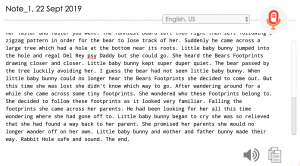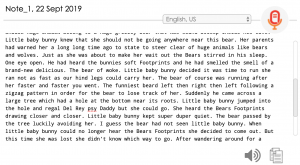


Voice to Text Story:
Once upon a time there used to be a little baby bunny that lived by herself in the forest one day this little bunny decide. Wanted to go on a little Adventure all by herself so without telling her parents she left the rabbit hole and the guide hop down the path deeper and deeper into the woods. After hopping for a while, the baby bunny came across footprints. She began to wonder who these Footprints might belong to. Suddenly she saw. Prince we’re heading is Deering off into a different direction so she decided that she would follow that direction instead of the path leading into the forest. She began following the footsteps for a long time. Suddenly she came across a case. She didn’t know what she should do next. The cave was dark and big she could hear noises coming from it. The little baby bunny began getting scared. At the same time she was also curious and a little hungry she decided she might be able to find some food inside the cave so it was worth taking a look inside. Felicia her way across entering the mouth of the cave. She went further inside to take a peek. Inside she saw a huge Shadow huge Shadow belong to a huge grizzly bear that was sound asleep inside his cave. Little baby bunny knew that she should not be going anywhere near this bear. Her parents had warned her a long long time ago to state to steer clear of huge animals like bears and wolves. Just as she was about to make her wait out the Bears stirred in his sleep. One eye open. He had heard the bunnies soft Footprints and he had smelled the smell of a brand-new delicious. The bear of woke. Little baby bunny decided it was time to run she ran not as fast as our hind legs could carry her. The bear of course was running after her faster and faster you went. The funniest beard left then right then left following a zigzag pattern in order for the bear to lose track of her. Suddenly he came across a large tree which had a hole at the bottom near its roots. Little baby bunny jumped into the hole and regal Del Rey psy Daddy but she could go. She heard the Bears Footprints drawing closer and closer. Little baby bunny kept super duper quiet. The bear passed by the tree luckily avoiding her. I guess the bear had not seen little baby bunny. When little baby bunny could no longer hear the Bears Footprints she decided to come out. But this time she was lost she didn’t know which way to go. After wandering around for a while she came across some tiny footprints. She wondered who these Footprints belong to. She decided to follow these footprints as it looked very familiar. Falling the footprints she came across her parents. He had been looking for her all this time wondering where she had gone off to. Little baby bunny began to cry she was so relieved that she had found a way back to her parent. She promised her parents she would no longer wander off on her own. Little baby bunny and mother and father bunny made their way. Rabbit Hole safe and sound. The end.
Analysis:
I thoroughly enjoyed completing the task for this week and learned a lot from my first experience with a “speech to text” application. For this particular task, I decided to use the website called “Speechnotes” on my laptop. I quickly discovered how difficult this task was. What I struggled with most was coming up with a story impromptu without having it planned out in my head beforehand. I found that I had to pause several times to think about what I was going to say next in the story. I even ended up switching around words but since it was “text-to-speech,” everything I was saying was being recorded.
Throughout the process of recording, I discovered many “mistakes” that were being made. I quickly realized that the text did not include any kind of punctuation unless I specifically said so. For example: I had to specifically say, “period” or “comma” in order for those punctuation marks to appear in the text. For the most part, I tried to say “period” after every sentence, however, I completely missed saying any other punctuation marks. In addition, I realized that some of the words that I said, were not accurately transcribed by the application (there were words that made no sense such as: the application writing case instead of cave). Because the story was made up on the spot, even after re-reading the text, I could not remember or figure out what exactly I had said at the time. All these are considered “mistakes” because they would not be acceptable in written text. Written text needs to follow the rules for proper punctuation and spelling.
If I had the chance to script the story beforehand, I would have taken my time to say the words more slowly and clearly in order to increase the accuracy of the transcribed text. There would be less pauses and fumbling of words since I would be reading out what I had written. I believe the “speech to text” would be more successful and accurate in this case. I found that as I was recording the story impromptu, my pace of speech was very inconsistent and this may have contributed to the multiple “mistakes” that were made in the text.
There are many ways in which oral storytelling differs from written storytelling. The number one way is the absence of punctuation. When you are telling a story verbally, you don’t state out loud the punctuation marks that would be included if the story was being written down. In oral storytelling, your pauses, tone of voice, and volume are used instead as a way to illustrate the effect that punctuation has in a written story. The second way is writing conventions like spelling and capitalization. In oral storytelling spelling and capitalization do not matter, whereas in written storytelling they do. In addition, in oral storytelling, the narrator usually changes their tone of voice to illustrate different characters that are speaking. In written storytelling, quotation marks are used along with the name of the character that said those words. Lastly, oral stories, when retold, are often changed or altered depending on what the person who is telling the story remembers most or what part of the story may have impacted them the most. The storyteller adds in a bit of their own personality when telling the story through the words they choose and the voice tones they use and you are able to get a glimpse of the story from their perspective. In this sense the text is “fluid” or “versatile” and can be moulded however the speaker wants. In written stories, the text is permanently visible on the page and does not change. As you read the story, you are able to recreate it in your head, the way you imagine it and this differs from reader to reader but the facts within the story remain the same.